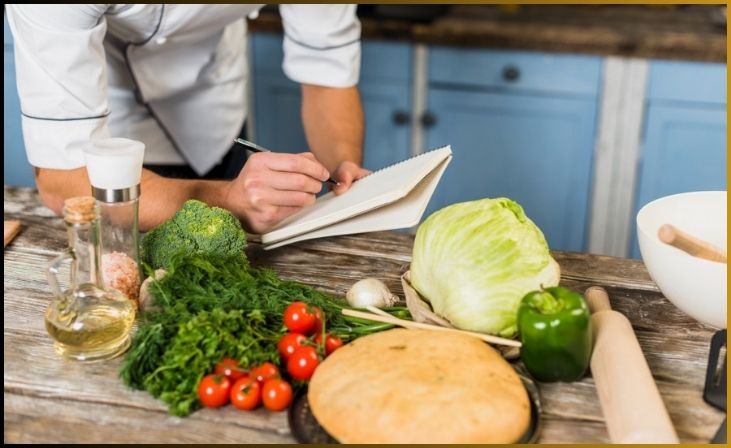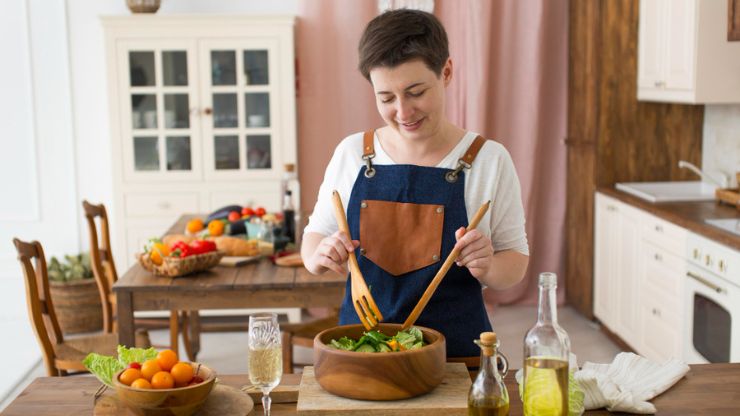One of the greatest frustrations my widowed mother faced in the kitchen was cooking for just one person. After raising a large family, she was accustomed to cooking in quantity. She was not alone. Young single people also need to adapt recipes written for the typical household of four to six. Here, Sarah gives some great tips to help with this dilemma.
While I love experimenting with fermented foods and new recipes, there is one awkward thing that most recipes have in common—they are for large quantities. As a single person living alone, I don’t need a gallon of dill pickles or any other recipe. But, when that’s what the recipe is written for, what am I to do?
Learn how to adapt recipes for one person, that’s what. Fermentation works best when built on the basis of ratios, percentages, and a healthy dose of experimentation. There are certain best practices that anyone can follow for a successful ferment, and within those best practices are a wealth of options, variations, and room to have fun.
Table of Contents
ToggleThings to Consider When You Want to Adapt Recipes
Here are three things that you need to consider before cooking food for one person.

Fermentation Ratios:
The first thing to consider when desiring to shrink a recipe is the ratio of salt to water/jar volume. This is the easiest ratio to maintain for a successful ferment, but also the easiest one to mess up on and have your ferment go soft. The salt is what enables your lactobacilli bacteria to flourish, and it is what keeps your ferment crisp, even after storing it for months.
The average fermentation ratio is 2/3 of a teaspoon salt to one cup of water. So a pint jar usually only needs 1-1/3 to 1-1/2 teaspoon salt, while a quart jar usually needs about 1 tablespoon of salt. A very finely minced ferment may need a touch more salt, as it ferments faster and has a higher propensity for going soft.
You can figure out the ratio in an average recipe by calculating the number of teaspoons of salt, (3 tsp per tablespoon), and the cup volume of the jar and dividing the salt into the water. Then calculate the cup volume of the jar you will be using and salt accordingly.
Fermentation Time:
A gallon jar may take up to two weeks to fully ferment successfully, even under prime fermenting conditions. A pint can ferment in two days in prime conditions or a week in cooler sub-prime conditions. Doing smaller fermentation batches means that you need to keep a closer eye on your ferment, just to make sure it doesn’t over-ferment. While over-fermenting isn’t usually a problem, it can change the texture of the food and make it less pleasant to consume. Personally, I like a crisp and slightly crunchy ferment, so when a ferment accidentally goes into a softer texture I will avoid eating it, even if it is otherwise a perfect ferment.
Spices and Flavorings:
Most recipes will either give you an exact quantity or measurement for spices or will say the ambiguous “to taste.” Now the challenge with ferments is that the taste changes and it’s super difficult to tell beforehand how much spice will be enough, and not too much.
If you are given an exact spice measurement, like twenty garlic cloves for a gallon of garlic dill pickles, you can create a similar ratio to that used for salt. A gallon is, roughly, sixteen cups of liquid, if you have 20 cloves of garlic it is 1.5 per cup. A pint jar version would have only 3 garlic cloves so that the spice was not overwhelming, a quart would probably be comfortable with 6 cloves.
You can figure out a similar ratio for most spices used in ferments, even ones such as ginger. If you personally like your ferments more, or less, spicy you can also adapt each recipe to your personal taste. The ratio idea is just to help give you a quick estimate of how much you will need, for the jar size you have.
Don't just scroll, subscribe!
BuzzTrail's unique web-stories are the cure for boredom you've been waiting for.
Fermenting is fun, and it doesn’t need huge jars that take over your entire fridge to be successful. Don’t be afraid to experiment with smaller jars, try different recipes, and generally have fun. This is one time it’s perfectly acceptable to play with your food, it’s fun and healthy!
Quick Link: Classic USA Pickled Recipes- A Tangy and Timeless Tradition
6 Useful Tips to Adapt Recipes for One Person

There are a number of methods to simplify cooking, including how you buy, how you prepare food, and what you eat. You’ll save money each week by following these tips to reduce food waste.
1. Plan your meals around a list of items.
Living with multiple people allows for more extensive grocery shopping, ensuring that a variety of vegetables, proteins, and fruits are consumed. However, when shopping for just one person, it’s essential to be mindful of purchasing in excess. To prevent food waste and culinary monotony, consider a selection of versatile vegetables like bell peppers, onions, mushrooms, and spinach. These ingredients can be creatively incorporated into numerous dishes, from quiches and tacos to pasta, rice, and soups, ensuring a diverse and satisfying culinary experience while efficiently managing fresh food resources.
2. Regularly visit the deli counter.
When in need of meats, seafood, or cheeses, consider visiting the deli counter. This allows you to order precisely the quantity you require, eliminating the risk of bringing home large, potentially wasteful portions of chicken or cheddar that might spoil before consumption. Furthermore, the deli counter offers the advantage of obtaining exceptionally fresh ingredients for your upcoming meals. By selecting only what you need, you can minimize food waste and savor the quality of your culinary creations, ensuring that every ingredient is as fresh as possible.
3. Learn one-person recipe scaling.
Simplify your cooking for one by obtaining or creating a conversion chart and keeping it accessible on your refrigerator or even framed on your kitchen wall. Your smartphone can also be a valuable tool for transforming larger measurements into single servings. For instance, when the craving for a hearty lasagna meant to serve six strikes, a quick glance at the chart or a few taps on your phone can help you easily adjust ingredient quantities to match your solo dining needs. This practical approach ensures that you’re not overwhelmed with leftovers and can enjoy perfectly portioned meals tailored just for you.
4. Be creative with spices.
Efficiently manage an abundance of a specific protein, vegetable, or grain by dividing it into portion-sized servings for various meals. The key to keeping your taste buds excited is in the art of seasoning. Experiment with a variety of seasonings, spices, sauces, and marinades to transform a single ingredient into multiple delectable dishes. For example, a batch of chicken can become a savory stir-fry, a zesty curry, and a tangy barbecue meal simply by switching up the seasonings. This creative approach keeps your meals diverse and prevents culinary monotony, making cooking for one an enjoyable culinary journey.
5. Buy a tiny slow cooker.
Consider acquiring a compact slow cooker tailored for single servings. Standard slow cookers can be oversized for preparing individual meals, but a smaller variant is the perfect fit. The beauty of this kitchen appliance lies in its convenience – simply load your ingredients in the morning, and by the time you return home, a scrumptious, fully-cooked meal awaits. It’s an efficient solution for solo dining that allows you to savor the pleasures of slow-cooked dishes without the hassle of adapting large recipes for one person.
6. Start with simple recipes.
Whipping up dishes like sandwiches, omelets, and quesadillas simplifies the cooking process for one person, eliminating the need for complex ingredient adjustments. With a repertoire of straightforward single-serving recipes at your disposal, meal preparation becomes a breeze. These culinary gems allow you to craft a delightful meal swiftly and effortlessly, without the hassle of recalculating measurements. They’re a go-to choice for solo dining, ensuring you enjoy delicious, hassle-free dining experiences with ease.
Bottom Line
Adapting recipes for one person empowers you to explore your culinary creativity while ensuring that your meals are perfectly portioned. With the right approach and a few essential strategies, you can enjoy a diverse and delicious menu tailored to your individual needs and preferences.
FAQs
How do I adjust cooking times when adapting a recipe for one person?
How do I adjust cooking times when adapting a recipe for one person?
When scaling down a recipe, cooking times often remain the same. However, it’s essential to monitor your dish as it cooks and use visual cues and doneness tests to determine when it’s ready. Smaller portions may cook faster, so keep a close eye on your meal.
What are some common ingredients that can be easily portioned for one person?
What are some common ingredients that can be easily portioned for one person?
Ingredients like rice, pasta, vegetables, and proteins can be portioned accurately for one person. Consider using measuring cups or a kitchen scale to ensure precise amounts, especially for dry ingredients.
Can I freeze portions of a recipe adapted for one person?
Can I freeze portions of a recipe adapted for one person?
Yes, you can freeze extra portions for future meals. Invest in quality freezer-safe containers, label them with the date, and store them for later use. Just remember to thaw and reheat properly when you’re ready to enjoy them.
Are there any specific tools or utensils that can help with adapting recipes for one person?
Are there any specific tools or utensils that can help with adapting recipes for one person?
Tools like small-scale kitchen scales, measuring cups, and portion control containers can be valuable when adapting recipes for one person. They enable you to measure ingredients accurately and store leftovers conveniently.

